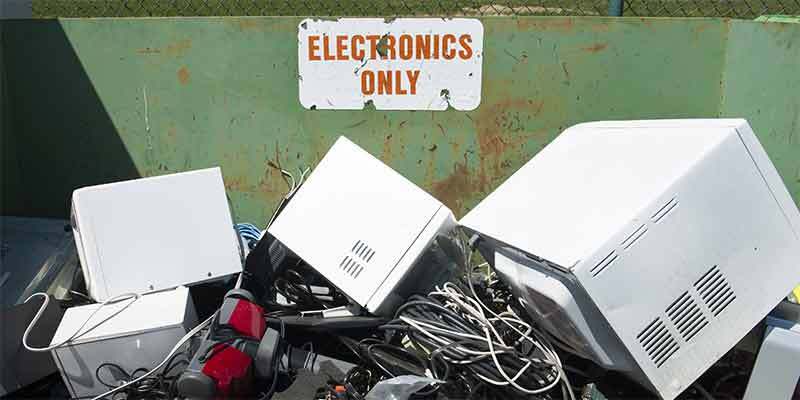Last Updated on July 27, 2023
Welcome to our article on the topic of “Where Can I Dispose Of Electronics?” In today’s digital age, electronics have become an integral part of our lives. However, with the constant advancement of technology, it is important to address the issue of proper electronics disposal. Improper disposal can have detrimental effects on the environment and human health. Therefore, it is crucial to understand the various options available for disposing of electronics responsibly. This article will explore recycling centers, local government programs, retailer take-back programs, online recycling options, donating to charitable organizations, trade-in programs, and safety precautions for electronics disposal. By the end of this article, you will have a comprehensive understanding of how to dispose of electronics in an environmentally-friendly manner.
Importance of Proper Electronics Disposal
Proper disposal of electronics is crucial for several reasons:
- Environmental Protection: Electronics contain hazardous materials such as lead, mercury, and cadmium, which can contaminate soil and water if not disposed of properly.
- Resource Conservation: Electronics contain valuable materials like gold, silver, and copper. Recycling them helps conserve these resources and reduces the need for mining.
- Data Security: Improper disposal of electronics can lead to data breaches and identity theft. It is essential to ensure that personal and sensitive information is securely erased before disposal.
By disposing of electronics responsibly, we can protect the environment, conserve resources, and safeguard our personal information.
Recycling Centers for Electronics
Recycling centers are an excellent option for disposing of electronics in an environmentally friendly manner. These centers are specifically designed to handle electronic waste and ensure that it is recycled properly. They have the necessary equipment and expertise to safely dismantle and recycle various electronic devices.
When you take your electronics to a recycling center, they will be sorted and separated into different components. Materials such as metals, plastics, and glass can be extracted and reused in the manufacturing of new products. This helps to conserve natural resources and reduce the need for raw materials.
Many recycling centers also offer drop-off services, making it convenient for individuals to dispose of their electronics. Some centers may even provide pick-up services for larger items. It is important to check with your local recycling center to find out what types of electronics they accept and any specific guidelines they may have.
By choosing to recycle your electronics at a dedicated recycling center, you can be confident that your devices will be disposed of responsibly and that any valuable materials will be recovered for reuse.
Local Government Programs for Electronics Disposal
Local government programs are another option for disposing of electronics in a responsible manner. Many municipalities have established programs to help residents properly dispose of their electronic waste.
These programs often include designated drop-off locations where individuals can bring their electronics for recycling. Some municipalities may also offer curbside collection services for electronic waste.
Local government programs are typically free or have a minimal fee associated with them. This makes it accessible for individuals to dispose of their electronics without incurring additional costs.
When utilizing a local government program, it is important to follow any guidelines or restrictions they may have. This may include requirements for removing personal data from devices or limitations on the types of electronics that can be accepted.
By taking advantage of local government programs, you can ensure that your electronics are disposed of properly and in compliance with any regulations that may be in place.
Local Government Programs for Electronics Disposal
Local government programs play a crucial role in providing safe and convenient options for electronics disposal. These programs are designed to ensure that electronic waste is properly handled and does not end up in landfills or harm the environment. Many cities and towns have established collection centers where residents can drop off their old electronics for recycling.
These programs often accept a wide range of electronic devices, including computers, televisions, cell phones, and small appliances. Some local governments even offer curbside pickup services for electronics, making it even more convenient for residents to dispose of their old devices.
When utilizing local government programs for electronics disposal, it is important to follow any guidelines or restrictions that may be in place. This may include removing personal data from devices, ensuring that batteries are properly disposed of, or adhering to specific drop-off hours.
By taking advantage of these programs, individuals can contribute to the proper disposal and recycling of electronic waste, helping to protect the environment and conserve valuable resources.
Retailer Take-Back Programs
– Retailer take-back programs are a convenient option for disposing of electronics.
– Many retailers offer these programs as a way to encourage responsible disposal of electronic devices.
– These programs allow customers to bring their old electronics to the retailer and drop them off for recycling.
– Some retailers may even offer incentives, such as discounts or gift cards, for participating in their take-back programs.
– Retailer take-back programs are often free of charge, making them a cost-effective option for electronics disposal.
– It is important to note that not all retailers offer take-back programs, so it is recommended to check with your local retailer before bringing in your electronics.
– Additionally, some retailers may only accept certain types of electronics, so it is important to inquire about their specific requirements.
– Retailer take-back programs are a great option for those who want a hassle-free way to dispose of their electronics while also supporting responsible recycling practices.
Online Electronics Recycling Options
Another convenient option for disposing of electronics is through online recycling programs. These programs allow you to send your old electronics to a recycling facility without leaving your home. Here are some benefits of using online electronics recycling options:
- Convenience: With online recycling options, you can easily dispose of your electronics from the comfort of your own home. All you need to do is package your electronics securely and ship them to the designated recycling facility.
- Wide Range of Accepted Items: Online recycling programs often accept a wide range of electronics, including computers, laptops, smartphones, tablets, and more. This means you can dispose of multiple devices in one go.
- Environmental Responsibility: By choosing online recycling options, you are taking a step towards environmental responsibility. These programs ensure that your electronics are properly recycled, reducing the amount of electronic waste that ends up in landfills.
- Data Security: Online recycling programs often have secure data destruction processes in place to protect your personal information. This gives you peace of mind knowing that your data will not be compromised.
- Accessibility: Online recycling options are accessible to people living in remote areas or those who may have difficulty accessing physical recycling centers.
When considering online electronics recycling options, it is important to research and choose a reputable program that follows proper recycling practices. Look for programs that are certified and have positive customer reviews.
Donating Electronics to Charitable Organizations
Another option for disposing of electronics is to donate them to charitable organizations. Many organizations accept used electronics and either refurbish them for resale or distribute them to those in need. Donating your electronics not only helps the environment by keeping them out of landfills, but it also allows someone else to benefit from your unwanted devices.
Before donating your electronics, it is important to ensure that they are in good working condition. Charitable organizations typically do not accept broken or non-functional devices. Additionally, it is a good idea to erase any personal data from your devices before donating them to protect your privacy.
When choosing a charitable organization to donate to, consider organizations that have a specific focus on technology or education. These organizations often have programs in place to provide electronics to schools, low-income families, or individuals in need of technology access.
By donating your electronics to charitable organizations, you can make a positive impact on both the environment and the lives of others.
Trade-In Programs for Electronics
Trade-in programs for electronics offer a convenient and environmentally friendly way to dispose of your old devices. These programs allow you to trade in your old electronics for credit towards the purchase of new ones. This not only helps you get rid of your old devices, but also gives you the opportunity to upgrade to the latest technology.
Many retailers and manufacturers offer trade-in programs for electronics. These programs accept a wide range of devices, including smartphones, tablets, laptops, and gaming consoles. Some programs even accept older models that may no longer be in working condition.
When participating in a trade-in program, it is important to ensure that your personal data is securely erased from the device. Most programs have procedures in place to wipe your data, but it is always a good idea to double-check and remove any sensitive information yourself.
Trade-in programs for electronics are a win-win solution for both consumers and the environment. By trading in your old devices, you can reduce electronic waste and contribute to a more sustainable future.
Safety Precautions for Electronics Disposal
When it comes to disposing of electronics, it is important to take certain safety precautions to protect yourself and the environment. Electronics contain hazardous materials such as lead, mercury, and cadmium, which can be harmful if not handled properly. Therefore, it is crucial to follow these guidelines:
1. Remove personal information
Before disposing of any electronic device, make sure to remove all personal information stored on it. This includes deleting files, wiping the hard drive, and resetting the device to its factory settings. This will help protect your privacy and prevent identity theft.
2. Disconnect and unplug
Prior to disposal, disconnect and unplug the electronic device from any power source. This will reduce the risk of electrical shock and prevent any potential damage to the device during the disposal process.
3. Check local regulations
Before disposing of electronics, check your local regulations regarding proper disposal methods. Some areas have specific guidelines and restrictions on how to dispose of electronic waste, so it is important to be aware of these rules to avoid any legal issues.
By following these safety precautions, you can ensure that your electronics are disposed of in a responsible and environmentally-friendly manner. Remember, proper disposal of electronics is not only important for your safety, but also for the well-being of our planet.
Conclusion: Proper disposal of electronics is crucial for both environmental and personal safety reasons. With the increasing amount of electronic waste being generated, it is important to know the various options available for disposing of these items responsibly.
Conclusion: In conclusion, it is evident that there are numerous avenues for disposing of electronics in a safe and environmentally-friendly manner. Whether it is through recycling centers, local government programs, retailer take-back programs, online options, donating to charitable organizations, or trade-in programs, individuals have the power to make a positive impact on the environment by properly disposing of their electronics.
Looking for the best places to dispose of electronics? Discover recycling centers, government programs, and more in this informative article.
About The Author

Alison Sowle is the typical tv guru. With a social media evangelist background, she knows how to get her message out there. However, she's also an introvert at heart and loves nothing more than writing for hours on end. She's a passionate creator who takes great joy in learning about new cultures - especially when it comes to beer!

